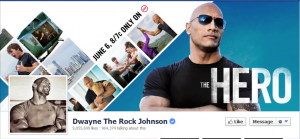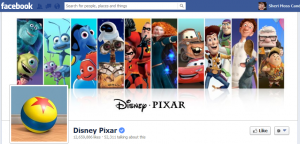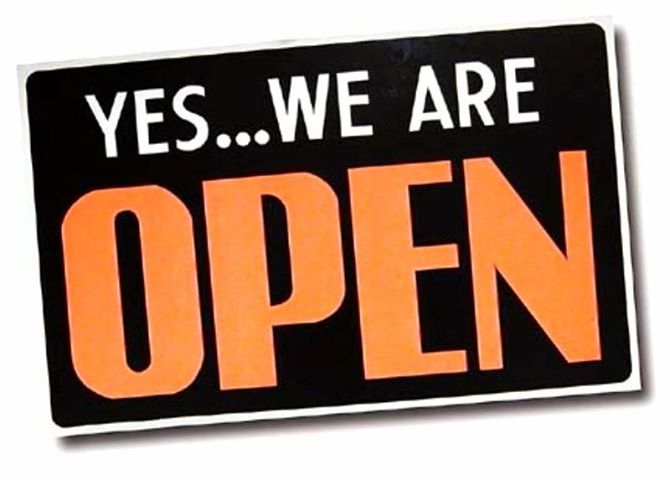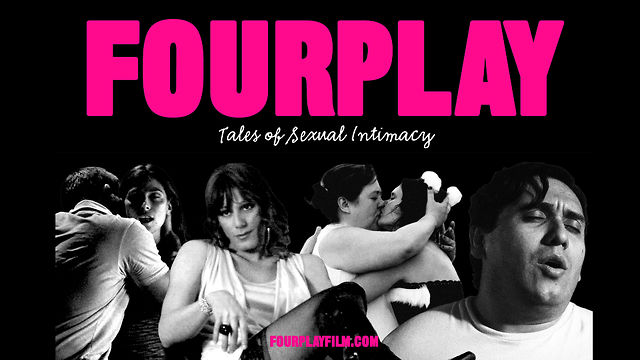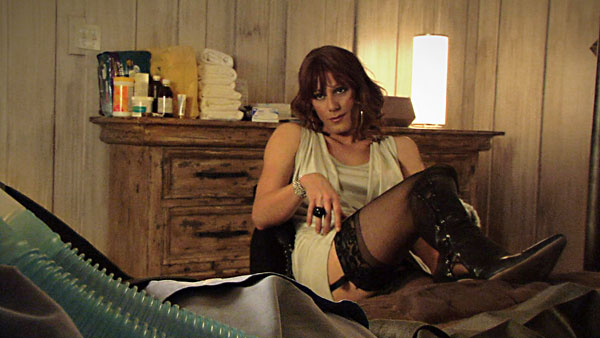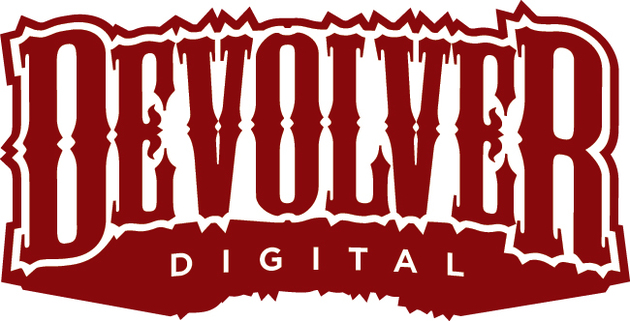
Finding distribution for the NC-17 equivalent film FOURPLAY
Today we have a guest post from filmmaker/educator Kyle Henry
Someone told me years ago that sex sells. Unfortunately, when I started making my anthology of short sex tales feature FOURPLAY four years ago, I thought that if a little sex sells then A LOT of sex would REALLY sell. Although the director side of my brain was motivated by a lot of high-minded reasons (e.g. showing sex as a positive force; providing understanding for characters participating in “deviant” sex acts; rescuing cinematic sex from titillation for catharsis), the producer side of my brain thought that by providing a product that would fill a need (e.g. an adult explicit film about sex that isn’t porn) somehow axiomatically would pull off a hat trick of making a profit AND getting away with subversive cultural critique. Well, we’ll see about that later part because just finding distribution has been a long and winding road depending almost exclusively on our persistence and ingenuity. Both were needed to prove the film’s potential to a very risk averse market for narrative NC-17 equivalent films dealing with sex even in our libertine digital age.
We didn’t start out five years ago making FOURPLAY thinking this would be such a struggle. I’ve always been interested and motivated to tell stories that challenge dominant frameworks of understanding. It’s the old activist in me still rearing its authority challenging head, but I thought that our four tales, which were mostly comedies, would hit that sweet spot of entertaining subversion. First word of warning: be wary of thinking your milieu of friends is representative of the general public as a whole.
Turns out, I live in a bit of a freak bubble. Now, there’s nothing wrong in making your work for yourself and your friends, just try to be aware how large that base is and don’t fool yourself that everyone is going to love your gang-bang heretical bathroom farce (e.g. our Tampa segment) or your cross-dressing sex-worker meets quadriplegic man for spiritual union melodrama (e.g. our San Francisco segment). I was very lucky to find grant money from the Austin Film Society, the wickedly funny producer Jason Wehling who likes doing things on the very cheap, and support from patron angel executive producers Michael Stipe and Jim McKay, who lent monetary and name support to the project via their C-Hundred Film Corp so we didn’t come off as complete yahoo wackos. Second word of warning: if you’re going to make a subversive work that will challenge the body politic and marketplace, make it on the cheap! All of these factors, plus the extreme desire to never again dip into my credit cards to make films, lead us to keep the budget under six figures, which gave us the ability to be not too desperate and come up with alternate strategies when hit with the brick wall of distributors saying “no thank you.”
Well, we were a little desperate in the beginning or perhaps a little too “creative” in our distribution thinking. There is a distributor out there who will go unnamed whose major selling point to filmmakers is a transparent “back-end” for their on-line sales of both DVDs and streaming content. That means when someone buys your content, you instantly see the sale by logging into their producer portal. We had the “clever” idea of releasing three of the four shorts that comprise FOURPLAY at both festivals and online as we finished them, with the idea being we’d make a little scratch along the way of production.
Production of the four shorts was strung out over the course of two years, basically whenever I had breaks from both teaching and editing, which I do also concurrent to directing to make a living because I don’t have a trust fund. Third word of warning: if you want to make subversive independent cinema in America have other skills that pay the bills or have a trust fund. No one that I know who is making this kind of work (and I know A LOT of filmmakers) is making a living exclusively from their directing projects.
Getting back to this unnamed distributor. After we finished the first short, our San Francisco sex-worker segment which premiered at Outfest in 2010, we signed up with this distributor and started streaming the segment. It was gratifying to see the hundreds of sales rack up on their “open architecture” site, but it was frustrating and irritating beyond belief never to get a check from them. One quarter, then two quarters went by with no payment. Emails and letters were sent, never to be replied to on their part. Finally, I had to get a lawyer friend involved, who luckily I met after making Room in 2005 and would only charge me poverty charity rates, but I still sunk around $500 that I didn’t have into legally harassing said distributor to get first payment and then rights back to the project when they never paid up and were flagrantly in breach of contract. Fourth word to the wise: have an entertainment lawyer friend!
Turns out, this distributor had not paid a lot of people. One filmmaker friend of mine literally had to march into their NYC offices and camp out in their lobby, refusing to leave until he got a check from them, or so the story goes. Fifth word to the wise word: always ask your filmmaker/producer friends for the straight dirt on a potential distributor before signing a deal. I wish we had done more research before falling for their “because you see it on our site you’ll definitely get paid” baloney. Digital transparency doesn’t equal material cash.
The second segment, our gang-bang farce in Tampa, hit the festival jackpot of premiering both at Cannes’ Directors’ Fortnight 2011 and Sundance 2012. This raised the project’s artistic street cred, but … as our most explicit, outrageous and heretical segment, I think it scared off any distributor that might have been attracted by those festival laurels. It has a lot of cock on display, fake prosthetic cock, but still enough showing to scare both the horses and the largest and most profitable online distributor of streaming content, who will also go unnamed. Luckily we have a friend inside said organization who took a gander at the film and told us straight out “too much cock” so we didn’t waste time or money trying to alter the work or submit via an aggregator.
The final anthology feature with all four segments premiered at Frameline last summer, and again I threw a final curve ball to another potential type of distributor, those who specialize in LGBT content, by including a “straight sex” and a lesbian bestiality segment. Granted, in the “straight” segment a couple conceives in a gay video porno arcade, and our bestial segment is more about sublimation than doing the nasty with doggie, but it didn’t help anyone narrow down who would be interested in our film. It’s seems we had something to both interest … but also offend everyone. So, another string of no thank you’s from everyone, and I mean everyone, as we played the festival circuit throughout the summer and fall in 2012.
By early fall, I knew if anyone was going to want to see the film, we had to find a cheap way of getting some reviews and attention to back up our assertion that the work would gain enough publicity and digital markers to direct traffic to at least our own DIY efforts (e.g. making a self-produced DVD available off our site, streaming via Distrify, et al) … but just maybe one of those no’s would become a yes. Going back to my activist days, I hired two former student interns to put together a database of every independent cinema in North America that had screened NC-17 content in the last few years. We then sent out e-mails to around 300 theaters, followed up with phone calls, mailed press-kits/dvds to 100 theaters who expressed interest, and persistently bugged for over five months a narrow set who didn’t say no out-right to end up with the twelve who screened the film either as full week (e.g. Austin’s Alamo Drafthouse, Denver’s Sie Film Center), multi-night (e.g. Portland’s Clinton, Seattle’s NW Film Forum, Chicago’s Siskel) or one-off runs (e.g. LA’s Egyptian, NYC’s LGBT Center, Longbeach’s Art Cinema). Since all prints were digital, I either delivered on Blu-Ray, DCP or QT file, all generously discounted by a very cheap institutional FedEx rate, one of the perks of academia. Finally, my partner Carlos Treviño is not only the brilliant writer of three of the four shorts, but is also a talented graphic designer who designed not only our DVD case but also our web-site, based on a great (and highly discounted) poster designed by filmmaker/designer Yen Tan. I’m also an editor by trade, so I designed the DVD. Sixth word: directors, have some skills and partner up with people with skills beyond directing! Doing everything in-house is A LOT cheaper than hiring a bunch of free-lancers. In all, we spent around $15K to do our limited theatrical and first batch of 1,000 DVDs, which also includes the cost of me traveling for Q&A’s to all twelve venues.
One of the biggest line-items was hiring a real publicist for theatrical, Matt Johnstone, who also publicized the festival launch of both the San Francisco segment at Outfest, the Tampa segment at Sundance and the final feature at both Frameline and Outfest in 2012. Matt was with the project for almost three years from that first festival launch and became quite invested in selling the project. We wisely chose Austin, my former hometown, as the site to launch our theatrical tour. Seventh word: build from your base, which doesn’t have to be NYC or LA. I got the idea from the way Rick Linklater built distribution for both Slacker and many years later Bernie. By opening in Austin, we got both huge feature articles in both the daily and weekly, but also great reviews (not a guarantee, but I was thankful) and additional TV and radio interviews. It was about as saturated of media coverage as we were ever going to get and it paid off not only with a modest box-office to help immediately repay some of the debt I had incurred, but also we instantly showed up on Rotten Tomatoes with two boffo reviews!
This is where persistence comes into play. Everyone told us that doing theatrical was stupid for a no-budget sex-film, but in this day and age you still need reviews and digital ink from reputable sources to get anyone to want to see your film on whatever platform you end up on. I couldn’t blow a lot of money on it though. Filmmakers routinely spend $30- $50K hiring a booker, paying to four-wall and hiring a publicist for LA and NYC markets only for the privilege of reviews. I did this in minor-markets for a third to a fifth of that cost to accumulate markers from decent sources, although not the NY Times, but there’s no guarantee the Times would’ve liked the film anyway. These great reviews attracted the attention of a person in the DVD division of TLA Releasing, one of those distributors who said no last year, but because the film was proving itself in the market-place of ideas, now was interested in re-selling our DVD. Because it cost them nothing to manufacture, and no advertising on their part, we were able to negotiate a decent straight up purchase of a sum of DVDs that instantly repaid me what I spent to manufacture the first 1000. Up on their site, pre-sales were available before the end of our theatrical, so press attention continued to drive up sales, allowing us to sell them another batch of DVDs that now has put us into profit on the DVD before its official release date. That certainly wasn’t the case for my first feature ROOM’s DVD deal. Finally, I think it just made sense for TLA, one of the major distributors of LGBT content, that the film was getting spotlighted for it’s LGBT boundary pushing creds and whatever negatives there were with varied content wouldn’t undermine the major critical take-aways they could sell.
Finally, our publicist came up with the great idea of selling TLA on VOD rights also, since we were doing a press-release for the DVD launch and all traffic could be directed to one site. Again, this was a win-win situation for the distributor, as it required almost no work on their part, guaranteed sales, and provided us with the legitimacy of having a one-stop-shop on a press-release so sales could be maximized through focusing on one link in reviews instead of confusing consumers by sending them to multiple platforms. The legitimization we earned through good press during our limited theatrical lead to confidence being built that there actually was an audience for our weirdo film and gave everyone publicity ammunition to prove this assertion. No one was going to make this happen for us, we had to do this ourselves, and that’s my Final Word of Advice: DIY is here to stay for independent filmmakers.
When I first got into Sundance and Cannes in 2005 with my feature Room, I thought I had “arrived” and that upon being purchased by an international sales agency the film would sell itself. Although Celluloid Dreams poured a decent amount of money into sales, publicity and advertising to sell the film to various markets, the experience taught me that your job as a filmmaker is to CONSTANTLY sell your film once its made, no matter who picks it up or in what form for distribution. Distribution and sales companies are like roulette tables. They put down many chips on the table and if the ball lands on a number, all the other numbers lose, and the company will naturally follow a winner to the exclusion of all the “losers.” You want your film to win by being seen and, ideally, also make back a bit of you and your investor’s money. By keeping my production costs low, but producing my work with a combination of grants, crowd-source funding, and small investments from what I’d deem as “patron” investors who are far more interested in whatever “cause” my film is promoting than in returning a profit, I had the flexibility to be persistent.
That persistence was also fueled on the cheap, with: dogged interns who gained valuable insight into the distribution process while not breaking my bank; through a long six-month booking process that allowed said interns to work for cheap because it was only part time while they worked their real jobs to survive; through my academia network, which built relationships with presenting non-profits in every market to build audience and outreach for discussion on issues surrounding sexuality just like a doc filmmaker would organize; and through building long terms relationships with professionals who are also friends, like our publicist, our producers and my lawyer, who stick with me and the film on bargain rates because in some way they support me and the work as a team.
This has been the real hat trick, not only finding distribution and some sort of on-line home for an NC-17 equivalent film, but continuing to build long term relationships with other creatives who might be down for yet another subversive adventure when the next film inspiration strikes.
FOURPLAY is now available on DVD/VOD streaming from TLA here http://www.tlavideo.com/gay-fourplay/p-350944-2
FOURPLAY official web-site http://www.fourplayfilm.com/
Kyle Henry is a filmmaker, editor and educator. His narrative feature Room debuted at Sundance and Cannes’ Directors’ Fortnight in 2005. He is also the editor of the Emmy Award winning 2011 documentary Where Soldiers Come From, as well as this year’s SXSW premier doc Before You Know It. He currently teaches film production at Northwestern University.
Sheri Candler May 15th, 2013
Posted In: Digital Distribution, Distribution, DIY, Film Festivals, Marketing, Publicity, Theatrical
Tags: Alamo Drafthouse, Art Cinema, Austin Film Society, C-Hundred Film Corp, Cannes, Carlos Trevino, Celluloid Dreams, Clinton, FOURPLAY, Frameline, Jason Wehling, Jim McKay, Kyle Henry, LGBT, LGBT Center, Matt Johnstone, Michael Stip, NC 17, NW Film Forum, Outfest, Room, sex positive, short films, Sie Film Center, Siskel Film Center, Sundance, TLA Releasing, Yen Tan
Digital distribution AND marketing support is the aim of Devolver
Just prior to SXSW, I was contacted by a new digital distribution outfit called Devolver Digital Film who were launching during the festival. I rolled my eyes as I opened the email because frankly, digital distributors are becoming a dime a dozen and few offer anything that differentiates their services. Yes, they are all non exclusive, but most do not have much to offer in the way of audience recognition of the platform.
Film distribution in some fashion isn’t difficult to obtain anymore…but getting an audience to know a film is available, actively seek it out AND getting them to watch it is another story. So, I was intrigued to find out that Devolver is planning to help solve that problem. Devolver Digital Films is a company expansion out of video game publishing and distribution. Devolver is primarily known for the Serious Sam series of games and their success within the video game industry coupled with founder Mike Wilson’s filmmaking interests lead to a desire to use the same successful game marketing techniques for independent films.
The company’s first title, Cancerpants, is described as “a story about life, love, and a young woman’s journey with breast cancer.” Cancerpants is currently available on VOD networks Verizon and Frontier, and will reach Comcast, Cox, Cablevision, and Dish Online on June 4th. Local theatrical screenings are planned for May 30th in several cities including Grass Valley, CA (hosted by the filmmaker), Los Angeles, Austin, Houston, Oakland, and New York City.
I spoke with Andie Grace, VP of Acquisitions, and Mike Wilson, Partner and filmmaker, to hear what lead to Devolver’s foray into independent film distribution and what they plan to offer that other digital distributors don’t.
AG: “The experience that motivated the creation of Devolver Digital Films comes from the games space. Mike is also a filmmaker and he knows what it is like to run up against the wall of getting distribution. After spending years of making the film, getting your own network together, hitting the festival circuit and landing a distributor and then they put it out, but do little to support it. Devolver Digital would never put out a game that way and now there are so many films on the digital shelves too, a small film that is great could do a lot better with a little help.
When a filmmaker’s own network is exhausted, they themselves are exhausted and ready to move on to another project, they just need a partner to be interested enough to work the title and we saw it as a niche to be filled.”
SC: “Speaking of a niche, does Devolver have a niche audience that they are serving with films? My main problem with film distributors is they don’t really have an audience for their company. They are used to speaking to other businesses (exhibitors, video stores, broadcasters), but not speaking directly to any audience for their titles. Their titles are so diverse that they don’t even really know who is watching. Will this be a unique aspect for Devolver? Is there a Devolver audience?”
AG: “Genre fans definitely stick with a label because of what the label brings them. This is definitely true in the games space. We now have many gamers saying ‘What is my favorite game label going to do with movies?’ So our aim is to keep that fanbase alive and choose films we think they will like.
A lot of counter culture films are coming our way and I definitely look at those films and say ‘I know where to find people who will like this, I know how to organize events around this.”
MW: “Our brand will be built on films that we believe we can make bigger than they would have been without our help. Decisions on films will be based purely on what we think we can do with the network we already have in place. It won’t be according to genr. Inevitably everyone wants us to do films that are considered ‘gamer’ fare. But people who are outside of the gamer world don’t realize that gamers aren’t only into zombie movies or sci fi movies. The independent gamer tends to like lots of independent entertainment. Independent music, independent films, they tend to look a little further past the mainstream. More interesting, less predictable. So that is what we will specialize in.”
SC: “Is there something that the filmmaker has to bring with the project? Do they have to have a certain mentality? Do you want the filmmaker to be an active participant in marketing his/her work, or are you fine with them leaving it with you to make it successful?”
MW: “There are 2 kinds of filmmakers. Those that are exhausted from making the film and just want someone to take care of the rest for them. Some of those are very good films, but there is no promotional hook, and no niche we can tap easily. If they just want it out there, use our service to get it into the world, we’ll put it out for you and you can move on with your life.”
AG: “But we regard this as a partnership. We amplify what they have already started doing on their own. Anyone who wants to just turn tail and walk is probably not going to work well with us. Now, we do understand that by the time the film is ready for distribution, the filmmaker has already exhausted their network and they have done all they know how to do with their Facebook page or Twitter account and they need someone to help them, do it with them. It’s better for them to stay present, be there for the interviews, help craft the story, and use the opportunity to build their own brand as a filmmaker by working with us in a promotional partnership.”
SC: “What will be the range of services Devolver offers? I was thinking it was just digital distribution platforms, but you are working with Tugg to do events too?”
AG: “We will offer cable VOD and internet VOD right now. Being from the games world, we also have our eyes on gaming consoles. We will talk about the total distribution strategy based on the film. It may include using tools like Tugg to do some live event screenings rather than spending time exclusively on the festival circuit. Events can help power the VOD sales. We also will talk about the marketing and publicity, some of the more traditional tactics. We will motivate our own networks to help with promoting screenings. By having the film on VOD when it is in theaters, we can get it highlighted in the ‘in theaters now’ sections of Amazon Instant and such.”
MW: “We are going to be direct to the platforms when that is possible, but until we build up our catalog, it isn’t realistic to think we will be big enough to negotiate direct deals with the bigger players. With our zero overhead, we will be competitive with the percentages we take even when a third party is involved. Plus, we’re going to help promote it which should make the revenue bigger than it would if you went through an aggregator who isn’t doing that.”
SC: “Do you take rights over the film or do those stay with the artist?”
MW: “We wouldn’t take all rights like broadcast network rights, or international rights at the moment. But to the extent that we do put time in to exploit on certain platforms, we want exclusivity on those. It is just bad business for everyone if you have several companies pitching the same film. As a filmmaker, I know there are distributors who want to take all rights just in case in future they want to do something with them. That is not the case with us. Our reason for existence is to avoid that scenario, we have all experienced it as filmmakers ourselves.”
“We do ask for a minimum of one year with options to extend. Most cable operators do want a 5 year minimum. We have found on the games side that there are opportunities for digital bundles and we will want to include our films in bundles without having to keep going back to ask permission. We aren’t going to be releasing 30 movies a month or anything. The films we do have are precious to us and we will be working harder to make the small amount work for us and for the filmmaker.”
SC:”Advertising and promotion aren’t free, they often make up the majority of any kind of film release. Is this a service deal agreement where the filmmaker fronts the money for Devolver to spend or is this more like a traditional distribution situation where Devolver will front the money and recoup from revenue before the filmmaker sees any profit?”
MW: “This won’t be a six figure M&A budget. It is more like soft dollars from us in our organization and network of already existing connections. This is what helps support our games as well. Filmmakers will also be expected to help each other when they are on our label. So anything we provide from this network is just the cost of us doing business and we provide that.”
“Then, if there is an opportunity to buy into a promotional program or whatever, we’ll agree it with the filmmaker and write the check up front and share that cost. If the filmmaker gets a 60% split with us, we share the cost of the promotion.That’s the way we work in games too, it is purely situational. To the extent that they want to be involved, the filmmaker will sign off on any promotion we want to participate in and they will know the whole cost.”
“Another thing we feel is important is being completely transparent. If we do have to go through another distributor to get to a certain outlet, I will forward every royalty statement we get from that distributor so that the filmmaker knows what the revenues were. There has just been too much damage done by ‘Hollywood accounting,’ I use that term to mean all entertainment. The games industry is as bad as any. The little things we can do to remove any doubt about whether we are on the filmmakers team, we will do. The world may not need another VOD distributor, but one thing we will provide that others do not is transparency. There is always room for that.”
SC: “When is the best time for a filmmaker to approach you? In preproduction? Production? Post?”
MW: “I would say in post. We’re not a production company and we aren’t trying to influence the outcome of a movie. We can’t really have a conversation about a film until we know the level of quality it will be. Most of the people we are talking to are in fine cut or have a festival version that they still want to trim.”
AG: “We are having conversations now with people who are in post and it is pretty obvious who their audience is. We are also talking to people who are not going on the festival circuit, they are launching straight into distribution.”
MW: “We have many dream producers coming to us who get this online promotion stuff. We want to network them all together and help to promote each other.”
SC: “How will you bring them together?”
MW: “Google Hangouts I envision. I want just these producers who all have great ideas and are on the same label to get together and brainstorm with each other. Their films are all coming out near the same timeframe so I think some great creativity and excitement will come from it. I don’t think they imagine for a minute that helping someone else will hurt their own projects. It just makes their own network bigger, by aggregating everyone’s together.These are all young, smart, tech savvy producers who want to learn from each other.”
SC: “Well, that is definitely a differentiator for Devolver! Most distributors don’t bother themselves with bring together the filmmakers to help work with all the projects in the catalog. It means you really want to work with filmmakers who are giving, tech savvy and want to help make everyone’s work successful.”
MW: “The filmmaking process just sucks everything out of you, you are totally exhausted when finished and often you are the last man standing. The crew disappears after the wrap party. It will be great to have a company that knows this, pulls together a group of filmmakers in the same situation about to release their films and supports everyone.”
“It is really fun to be coming in at a time when we aren’t having to undo our skills. You go to industry panels where these veteran people are completely unsure of what is happening and frustrated at having to relearn everything because they are used to doing things in a certain way for many years. For us, it is exciting because it is wide open.”
I will be keeping an eye on this young and enthusiastic company. If you have a project you would like to approach Devolver Digital Films about, contact Andie Grace:
films [at] devolverdigital dot com
Sheri Candler May 9th, 2013
Posted In: Amazon VOD & CreateSpace, Digital Distribution, Distribution, iTunes, Netflix
Tags: Andie Grace, Cancerpants, Devolver Digital Films, Digital Distribution, digital distributor, independent film, Mike Wilson, Serious Sam, Tugg
Notes from an Arbitration-Lessons learned in suing an indie film sales agent

a guest post by Michael D. Akers
The world of distribution is changing constantly with the decline of DVD and the fragmentation of digital platforms. The challenges are even greater when you turn to the international marketplace. Like many filmmakers, we turned to a foreign sales agent to exploit the rights for our latest film MORGAN.
While we are going to use the word “agent/agency” in this article, we believe that inter-changeable terms could include Producer’s Rep, Distributor, Aggregator, Consultant, etc. Because, as we see it, these are the middlemen who can completely destroy you by failing at their intended purpose: to make you a profit. Many of these companies operate under the “more is better” practice where they will take on hundreds or thousands of titles so that the law of averages puts money in their pockets. While that may make sense for them, it makes no sense for the indie filmmaker. After all, we’ve taken all the risk.
A few thousand dollars one way or the other can determine when (or IF) we get to make our next films. We count on the expertise and diligence of these agents to get the best possible deals. We need them to be sharks. Our particular agent promised us high returns across more territories than we were capable of getting for ourselves. All the agent wanted was a commission. Sound too good to be true? It was.

So what happens when you have signed with an agent who is not marketing your film effectively, who is not selling your film for amounts that you feel comfortable with, and/or may not be trying to exploit your rights at all? Obviously you call them and try to work it out because, after all, you are supposed to be working together to make money for each other. But let’s suppose your agent is a total [expletive] who doesn’t even know what a deliverable is, and you want to terminate your relationship. You turn to your contract to see what recourse you have. If you feel really convinced you are right, you attempt to terminate it. That is what we did. And this is what we learned from suing our foreign sales agent to terminate our agency agreement.
1) ARBITRATION CLAUSE. Chances are that you have some kind of clause that may spell out how both parties are to resolve a dispute over the contract. You probably have never given it much thought. I know we didn’t. We had blindly accepted the language as standard, figuring the mere threat of arbitration was a deterrent from the proceeding itself. But, as our dispute rose to epic levels and arbitration became necessary, this paragraph became our master. Also worth noting, we found out that generally you cannot go to court if you have an arbitration clause (possibly if both parties agree, maybe) because a judge will send the case back to arbitration, ruling that the courts have no jurisdiction. This goes for appeals as well. Generally, courts will not hear appeals of arbitration cases. Nor will the:
2) ARBITRAL BODY: Look at the arbitration clause: Does it specify who the arbitral body is or under which state’s laws the contract will be interpreted? Does the prevailing party have the right to collect attorney’s fees? You may find, like we did, that we should have really spent time on this paragraph. We knew nothing of the arbitration company. Did they like indie filmmakers? Were they studio oriented? How much do they charge? What are their rules of process? You will be BOUND by these rules if you go to arbitration. Take the time to look up the company in your contract. Ask around. Had we looked into any of those questions, we would have NEVER agreed to use our arbitral body because of:
3) THE ARBITRATOR. The arbitrator is an attorney working somewhere in the entertainment industry (hopefully). You and the opposing party receive a list of attorneys to select from, along with their resumes. It’s not really possible to see what other cases they worked on or how they ruled in those cases. Your attorney may be able to find out more information about them, but it’s pretty tough. In our case, both parties agreed quickly to one arbitrator. This is great because we wanted the case wrapped up as soon as possible so we could get on with exploiting our film. No such luck. Upon meeting an arbitrator, you will immediately ask yourself, WHY would an attorney sign up to do this? Answer one: to bill you. Constantly. The arbitrator charges you for everything he does in the arbitration. He has no checks or balances in this regard. So if your arbitrator is trying to send his kid to college, you might as well sign over your car right now because he can make up any number of hours he wants and send you a bill. You have to pay it or you will default. Answer two: because he’s not qualified to be a REAL judge. So he’s going to take it out on you. Whatever his interpretation of the laws, whatever his opinion is of your film, your budget, your hair color, he can rule however he wants to. (As a matter of record, our arbitrator actually told us that nobody cares about our movie or this case.) And again, there are NO checks and balances on this because the arbitral body hides behind its motto:
4) AN INFORMAL, EXPEDIENT AND COST EFFECTIVE PROCESS. We elected not to have full time representation because of the cost. Our agent however did hire a full time lawyer. Even though we had the promise of an informal process, the arbitrator NEVER looked out for our best interest. He let the opposing attorney antagonize and threaten us. He let the opposing attorney cause repeated and unnecessary delays. He scheduled paperwork to be due while we were traveling on the film festival circuit. But he gave time extensions to the other side. He gave the opposing attorney such wide latitude in discovery that we turned in over 1000 pages of evidence! Meanwhile, he only required the opposing attorney to turn in about 10. So this impartial, expedient, cheap process was not our experience. Our arbitration took SIX months and cost a lot of money. The entire process from breach to verdict was a year because:
5) THE BEST OFFENSE IS A GOOD DEFENSE. From our experience, being the CLAIMANT (the party bringing the action, namely, us) puts in you a much tougher spot that being the RESPONDENT (the party being sued, the agent). We had to prove all of our claims, which meant that we had to turn over clear and compelling evidence. We thought we had plenty. But the arbitrator’s rulings slowly whittled away what we thought was our best evidence. The respondent does not really have to do anything. Our agent literally just sat on our film’s foreign distribution rights stalling all the energy we had been creating for a year. Now we might be in trouble on this one, but we really would consider just breaching the contract and exploiting the film ourselves (next time). It would then be up to our agent to prove the breach, the damages, etc. Definitely DO NOT consider this legal advice. It’s just our opinion.
6) AGENCY COUPLED WITH AN INTEREST. Scour your contract right now for this phrase. It is crucial when it comes to terminating your agreement. Now what we are about to say is only a general rule that (true to the law) comes with a million exceptions. Nonetheless, in an agency contract, you (as the principal) ALWAYS have the POWER to terminate a contract with your agent AT WILL.) It is imperative that you understand that you can still be liable for the damages that this causes your agent (i.e., the MG or license fee they already paid you, marketing expenses they can prove they spent, etc.). Our agent did countersue us for damages. But they also sued us saying that we did not have the RIGHT to terminate the agreement. As we are now painfully aware, the RIGHT to terminate is not the same as the POWER to terminate. As a rule, you CANNOT terminate your contract with an agent if it is “coupled with an interest.” That is to say, that the agent has some kind of interest “in the thing the contract is about.” What is this “interest”? What is the “thing”? Who the hell knows! It isn’t defined by the law. What the interest ISN’T has sort of been sketched out over the last hundred years. Generally, simple monetary considerations are NOT considered interest (i.e. commissions, payments, etc.). We thought we were well within our POWER to terminate because the agent did not pay any money upfront. And since the agent did not generate any deals other than those we brought to them, it would seem TWICE as obvious that our distributor had NO interest in our film. But, referring to #2 above, our arbitrator was grossly unqualified to interpret this kind of law (our research shows these agency coupled with an interest cases frequently end up in appeals court because of their complexity). Our arbitrator ruled that our contract was coupled with an interest because of some postcards that the agent had printed out in Berlin (have we mentioned that you can’t (technically) appeal?). I’m sure that now every distributor is now calling their attorney to add this paragraph, but if you, the filmmaker, can, keep it out. The agent is covered anyway, because in the event you terminate unfairly, you are on the hook for any damages that the agent suffers (and probably their attorney’s fees).
7) DEFINE DEFINE DEFINE. Boilerplate. Fear that word. Just because everyone thinks they know what marketing, customary efforts, good faith or even all-rights is, WRITE IT DOWN. This is your business and your money we are talking about. Define every single term. We did not do this. So when we claimed that our distributor did not use “reasonable and customary efforts” to license, market and sell our film; that they did not “consult with us” on this marketing and licensing of our film; that they did not generate offers that we could have gotten ourselves, we were on the hook to prove it. We thought it was obvious that our agent should have a Facebook page, and maybe post our movie on it, or on their website, maybe even the trailer (shocking!). At least they should have spelled our names right on their listing! To our 500 pages of print-outs, the arbitrator balked, saying that is was “unpersuasive.” Outline what you think reasonable and customary efforts are. We really recommend setting a minimum amount acceptable for the contract to remain in force. Define marketing. What efforts do you expect the distributor to make? Be as specific as you can. (I am now hearing horror stories of friends’ films sitting on their distributors’ shelves in limbo. They won’t be getting the rights back for years and the film won’t be generating any more revenue because the distributor finds it financially unviable to exert further effort.) Go through your contract as though you can be shot by a firing squad. Because that’s how it feels when you go into an arbitration hearing and every sentence is scrutinized by both sides, each interpreting it to favor their position. If the arbitrator can’t see clear convincing evidence that your definition is correct, you cannot prove a breach of contract.
8) CONSULT WITH AN ATTORNEY. A GREAT ONE. Unfortunately no lawyer could have reasoned with our agent in order to avoid arbitration. The lawsuit in and of itself was ridiculous. Though we only had an attorney on retainer for consultation, the way the arbitrator pushed us around made us wish we could have afforded complete representation (or an assassin). It is worth noting here that we changed our law firm part way through the proceedings. Just like the discussion of the arbitrator above, make sure your own attorney is qualified to handle your particular dispute. The law is complex and the process is a game. You need a fighter. You want to feel really great about who is representing you. Don’t be afraid to fire people. Keep looking until you find the right lawyer. How will you know? Trust me, you will.
9) KEEP RIDICULOUSLY COMPLETE RECORDS OF EVERYTHING THAT HAPPENS…EVER. So after all of this you may be surprised to find out that we prevailed. (Can you imagine what we’d say if we LOST?) How? Every single email, letter, check, even the envelope that the check came in. Yep, we keep all of that stuff and more. Why? Look through your contract and see if you find a paragraph that discusses how to amend/addend the contract. Usually it stipulates that it has to be done in writing. It turns out that most states consider email “written communication.” While we were not necessarily saving all of that paperwork to prevail in a court hearing, that’s what ended up happening. The agent not only lost their frivolous countersuit because of those emails, they were also held to a strange law in California under which two parties can “agree to agree” just by agreeing to the major terms of an agreement. (Confused? It would take a book to explain THIS law.) Specifically, in those emails, we had offered the agent a sum of money to settle the case. Though they originally agreed to accept it, they later reneged. The arbitrator ruled that the first agreement was permanent. Though it was on a technicality, a win is a win.
10) BE A SORE WINNER. But the award by the arbitrator was lackluster. He is a studio attorney who clearly thought that our case was frivolous and meaningless. He just couldn’t understand that to us, it meant everything. In the end, the arbitration cost us almost as much as our film and stole a year of our lives. We are now out to prove the arbitrator wrong. Filmmakers DO care about their movies and filmmakers WILL care about this verdict. He could have single-handedly moved independent filmmaking into a new era of mutual responsibility. But instead his final opinion read more like a warning to the distributor on how to fix their contract so that they can more assuredly screw over the next filmmaker.
11) TELL YOUR STORY. Since we’ve started going public, we are hearing many stories of frustration and anger about these agency relationships. Filmmakers worry that if they speak up, the agencies may retaliate. Well, here are two things you should know. One, they probably WILL retaliate. Ours did. They told film festivals, foreign sales agents, distributors and other people we do business with that our film was “unavailable.” They tied up our film’s distribution for almost an entire year. We were distraught. But then we realized number two: we are the content creators. Festivals, distributors, aggregators and (most importantly your fans) want your content. These agencies don’t have jobs unless someone makes them something to sell. Thankfully, we have been able to pick up where we left off, though the film’s value has certainly suffered from sitting on the shelf for a year.
As we sat in the hearing, reading aloud the angry emails that had flown back and forth between us and our agent, we were struck by a sad realization: this whole process was just a big waste of time and money. WE were paying the arbitrator to decide if WE had the right to terminate a contract with an agent who was supposed to be making US money by exploiting a movie WE paid for. Who were these people and why were they being granted ANY validity whatsoever? We are sharing our story in the hopes that it will help save some other filmmaker from falling into the same traps we did. And if you do find yourself having to take that big leap, remember: arbitration is war and you have to win by any means necessary.
None of this article should be construed as legal advice. This is our opinion base on our experience.
About the author:
Michael D. Akers is an American film director, producer, screenwriter and editor. In 2000, he founded United Gay Network (UGN) with his longtime partner, Sandon Berg. Morgan is Akers’ fourth in a line of genre defining films. His first film, Gone, But Not Forgotten, altered the queer indie landscape with an adept story made universal through common human drama and incidental sexuality and went on to win numerous audience awards after playing in more than 30 festivals world-wide. Gone, But Not Forgotten ultimately became one of the most successful independent LGBT films of all time.
Sheri Candler April 11th, 2013
Posted In: Distribution, International Sales
Tags: agency coupled with an interest, arbitral body, arbitration, arbitration clause, arbitrator, claimant, foreign sales agent, independent film, lawsuit, Michael D. Akers, MORGAN, Producer's rep, respondent, sales agent, United Gay Network
The Preacher’s Daughter-a low budget indie film that broke Lifetime records
There are many ways a film can reach its audience. While independent filmmakers often lock themselves into the path of securing a festival premiere, signing a sales agent, hoping for a sizable distribution deal that includes a theatrical release and sailing off into the sunset to make another film, they could be overlooking options that make better sense for the type of film they have.
TFC member Michelle Mower knows the indie filmmaker mindset well having worked for many years with Houston based organization Southwest Alternate Media Project (SWAMP). She too thought that her first feature film, The Preacher’s Daughter, would follow that same path. But after sending TFC’s Orly Ravid the rough cut of the film, advice came that altered her plans. I spoke with Michelle to find out how her film achieved distribution and succeeded in bringing Lifetime Movie Network its highest ratings for 2012.
SC: “Your case study is particularly interesting to me because your initial thought was you wanted to have a festival premiere and tour the circuit. But something totally different happened?”
MM: “Isn’t that normal for independent films? Isn’t the festival circuit what all indies are supposed to do? [laugh]”
SC: “Yes, totally what people think. But other opportunities came up for your film. First let me ask, how did you finance the film?”
MM: “We funded this film in stages. We raised our shooting budget first which was the ultra-low, $50,000 budget. But as we got into preproduction, we were able to attach name talent to the project, so we raised a little more and then as we got into production and post production, we got a few more investors to help us finish the film. It was very typical of most first features where you start with one budget, but end up with another and you struggle to get the film finished. We didn’t really know what would happen with the film, but we did feel like we had a great story, some very strong performances, some things that would definitely attract an audience.”
SC: “How long did it take to shoot and finish the film?”
MM: “We ended up with a total of 43 days for the shoot which is really long and I do not recommend it. We had crew changes and scheduling issues, so it caused us to prolong our production. Ultimately, it took us over a year to finish the film.
SC: “Was the film shot mainly in Houston, Texas?”
MM: “Yes, the whole film was shot in Houston and the surrounding area. The film is set in a small town in East Texas, so I shot it in the little towns surrounding Houston.”
SC: “Tell me about casting. How did you land Andrea Bowen?”
MM: “It’s a funny story. I sent out a casting notice in LA. Initially, I wasn’t intending to cast there because I didn’t think I could afford it. But I was out there for the Los Angeles Film Festival so I thought if I’m out there I might as well see what would happen. I posted on Breakdown Services, and within 24 hours I had 1400 submissions just for the lead role alone. I narrowed it down to a couple hundred and then my casting director went through those and we invited about 60 women to audition. 36 showed up and one of them was Andrea Bowen, from Desperate Housewives.”
“I had no idea who she was. I had seen Desperate Housewives, but not for years and she was probably around 13 years old when the show started. To say she nailed that audition was an understatement. She’s an extremely talented actress and it was very apparent that she knew what she was doing. When she left, I turned to the interns working with me and they told me who she was and I had mixed emotions because she was so awesome, but I didn’t think I could afford her. I wasn’t even going to waste either of our time in trying to contact her. But that was my naive reaction and I have learned since that actors do want to work, but they also want good roles. If you have a good script with a really strong role, they are willing to work with you.”
“Her agent contacted me, we sent over the full script. Andrea loved it and that gave me confidence in my writing because I am sure she reads scripts all the time. So we negotiated with them and were able to get her on board. She was wonderful to work with and I am sure the film would not have gotten nearly as far as it did without her.”
“Our male lead, Adam Mayfield, is from Houston so we had some mutual friends. He is based in LA too, and I was leery about bringing in too many people from other cities because of the budget constraints. But he was in town one weekend and we met for lunch and I just knew he was the right guy. He was just coming off of his role on All My Children and he wanted to work with Andrea so it all worked out.”
SC:”So what happened to change your course on distribution? Was the film premiered anywhere?”
MM: “I met Orly at the annual Business of Film Conference in Houston that is presented by SWAMP when I was in production and she told me to keep her apprised of what we were doing with it. I joined The Film Collaborative and once I had a rough cut, I sent it to Orly and asked her to give me feedback and guidance. I was thinking about festivals until she came back and said it wasn’t a festival film because it was too mainstream, too commercial in feel. It probably wasn’t going to be programmed by the bigger festivals. She said I needed to think about other options. We had already submitted to some festivals, like SXSW, and it did not get in so it made me rethink what I was doing with the film and look at other options.”
“Orly introduced me to Imagination Worldwide, a sales agency, because they often work in broadcast licensing. I sent them a one sheet and that made them ask to see the film. I sent them my rough cut and they asked to rep it for the cable market. This was November 2011 and they took it to EFM the next February. They always knew that it might be of interest to Lifetime, but I didn’t get my hopes up. I was really still trying to raise more funds to get it absolutely completed.”
“We went ahead and did the world premiere in Houston in April 2012, and in June we sold to Lifetime Movie Network. I did have to cut down the film because there is certain content that Lifetime won’t air, curse words and nudity and stuff. It premiered on August 31, 2012 on the Lifetime Movie Network, one of Lifetime’s specialty channels. It was the highest rated movie on the channel in all of 2012.”
SC: “Were you involved in the promotion of it and do you know what they did?”
MM: “I had been promoting it in my social network for a long time. I always thought it would go into the festivals and I would need my network, so I had a Facebook page for the film and we started our own audience building from the get go.”
“When Lifetime took the film on, their promotion came through TV ads. I expected the promotion on the Lifetime Channel because they typically do that, but I didn’t expect to see it on OWN, NatGeo and Bravo and all of these other cable channels. I asked my Facebook fans to let me know what channels they were seeing the promotion on and we counted 9 different networks. So they did a great job promoting it in the broadcast world.”
“I had been told earlier in the post production process that this was not a marketable film. It wasn’t a Christian film because it was too edgy and it wasn’t an indie film because it wasn’t edgy enough. But Lifetime was able to market it well.”
SC: “So in your deal with Lifetime, are you able to still sell internationally? Or sell on your own?”
MM: “My deal with Lifetime is for North American, Latin American and UK broadcast rights. Pretty much every other territory was open, but we have sold to about 7 other territories in the world now. We will have a DVD/cable VOD release this month in the US [DVD will be available on Amazon April 9). It will be the director’s cut so all the scenes that I had to cut out of the broadcast version will be back in. Per our contract with Lifetime, we cannot do Netflix, iTunes, Hulu streaming until after the license expires in 5 years.”
“If you had told me when I started this process that my movie would reach millions of people, I would have laughed. But things happen the way they do for a reason.”
SC: “I think it is wonderful for a first feature film to sell, repay the investors and air on a network where millions would see it. Not many first timers ever achieve that.”
MM: “I have seen many strong feature films in my former work with SWAMP and I have attended many workshops and conferences so I knew the challenges I faced as a first time feature director. I know it is very difficult to achieve distribution for indie films and even if you do, often it is for no advance or very low advance. If a theatrical release happens, it is for a one week run in New York and LA, the two most saturated markets for films. Then on to digital release where very little is done to promote it. In that scenario, it is nearly impossible to make money back for investors or for the filmmaker. My advance did repay my investors.”
“I started out thinking I wanted to go that route, the festival-theatrical-digital route. But when I faced the reality of it and thought about what the Lifetime offer meant, it was really a no brainer. Make your investors’ money back and have millions of people watch your film. Pretty simple decision really. Plus, because of that deal, opportunities come to me that weren’t there before. When I call for meetings, people take the call. I have people interested in what projects I am considering. Not only did I sell to Lifetime, it was a success for them so that helps get more interest from the industry for my work.”
SC: “So what is your parting advice for filmmakers, either new ones or those who are working on their second or third film?”
MM: “I sat on this script for 9 years because I was afraid. What would happen if I made the film? Would I put my family in financial hardship? I made all kinds of excuses for why I shouldn’t make it at that time. My advice is stop making excuses. Make your movie. No one is stopping you and there are opportunities to sell it if you are open to them. Figure it out and make it happen.”
Thanks Michelle, for your candid answers and hopefully there are a few filmmakers out there re-evaluating how they plan to release their films.
Sheri Candler April 4th, 2013
Posted In: Cable, Distribution, International Sales
Tags: Adam Mayfield, All My Children, Amazon, Andrea Bowen, Breakdown Services, Desperate Housewives, Imagination Worldwide, independent film, Lifetime Movie Network, Los Angeles Film Festival, Michelle Mower, Orly Ravid, Preacher's Daughter, Southwest Alternate Media Project, The Film Collaborative
Sundance video interview-Shaka King
Director Shaka King’s film, Newlyweeds, was included in the Sundance NEXT category for ultra low budget films and secured distribution through Phase 4 Films. Here he discusses the value of participating in filmmaking labs like those from the IFP, making short films, and using Kickstarter to successfully fund the film’s trip to Sundance.
Sheri Candler March 1st, 2013
Posted In: crowdfunding, Distribution, Film Festivals
Tags: IFP Labs, Kickstarter, Newlyweeds, NEXT, Shaka King, short films, Sundance Film Festival, video interview

